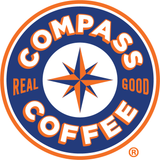Burr or Blade?
In general, there are two main types of coffee grinders: burr and blade. Regardless of the form factor of a grinder, it usually falls within these two main categories.
More often than not, when you see a grinder behind the bar at a cafe it’s going to be a burr grinder. Burr grinders are the industry standard due to their ability to produce consistent-sized grinds, which is key to proper extraction. After all, quality cafes are built on their ability to produce quality drinks consistently. As such, a ton of research--both online and old-fashioned trial-and-error--goes into selecting a grinder to carry the weight of your company’s reputation.
So why do we use burr grinders and not blade grinders? Does this mean blade grinders aren’t good?
Blade grinders are great!
They’re perfectly proficient at turning whole bean coffee into powdered coffee for brewing.
Blade grinders work by literally chopping whole bean coffee with a spinning blade. Imagine a helicopter turbine sitting inside a chamber. Now imagine filling that chamber with ground coffee and turning that helicopter turbine on. As the blade spins, it creates airflow to move the beans around inside the chamber. Whenever the beans come in contact with the turbine, they’re cut into smaller pieces. And the longer you keep the grinder on, the smaller the pieces. Seems great, right?
Well yes. And no.
Blade grinders are dependent on beans coming in contact with a spinning blade inside of a chamber, which happens randomly. The issue is that we can’t control which beans come into contact with the blade, when they come into contact with it, or how often they come in contact with it.
The result is that your beans aren’t equal sizes or shapes. Some might be ground finely and others might be coarse. Others might fall somewhere in between fine and coarse.
Also, considering that blade grinders operate by time rather than a size setting, getting in the proper grind-size ballpark can be a challenge in and of itself. Some recommend pulsing the grinder. Some recommend holding and counting. Regardless of which avenue you take, the process is fairly inaccurate.
Ultimately, Blade grinders are great if you’re just getting into home brewing. Typically, they’re smaller than burr grinders and therefore require less counter space. Blade grinders are also fairly less expensive than their burr brethren. As someone who lives in Washington, DC, I can definitely tell you that space is an important consideration when I buy home appliances; likewise, as someone who pays rent in Washington, DC, I can tell you price is another important consideration for me.
Taking it to the next level
As I mentioned earlier, burr grinders are the industry standard for professionals and prosumers. Rather than relying on chance encounters with a spinning blade for grinding, burr grinders work as coffee passes through a grinding mechanism made from either conical or flat burrs.
Though shaped differently, flat and conical burrs work the same way: a serrated ring spins around a burr with similarly serrated edges. The real difference between conical or flat burrs is the shape of the grinding surface.
As coffee moves through these surfaces, it’s ground into a uniform size based on the distance between the two surfaces. With a burr grinder, users can adjust the distance between the burrs which, in turn, adjusts the size of the ground coffee.
This reliable customizability means a world of difference when aiming for a properly extracted cup. Whereas blade grinders provide uneven grind sizes and shapes, meaning extraction time is different from particle to particle, burr grinders’ ability to produce uniformly even grinds means every single morsel of ground coffee has the same extraction time. There’s no variability at all and, provided you’re brewing correctly, there’s no chance of a surprise bitter cup as unexpectedly small grinds burn while brewing in hot water.
Furthermore, some burr grinders allow users to easily upgrade parts. Adding higher quality metal or ceramic burrs only adds to cup quality.
Personally, I use a Baratza Encore burr grinder with an upgraded M2 burr. It’s a great entry-level burr grinder that’s not too big and produces a great, even grind.
Do you grind your own beans? If so, what are you using?






